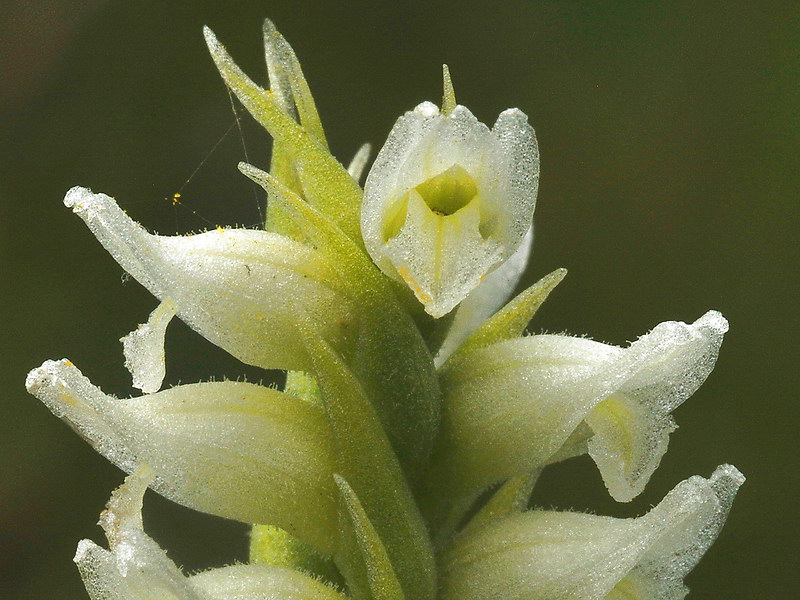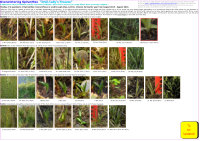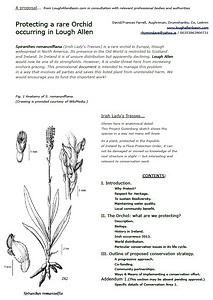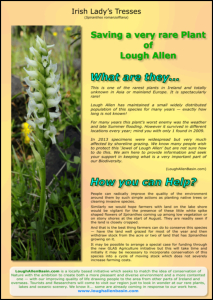A bit of Research! To cherish something special you need to understand it. In the paragraphs below we talk about problems and solutions (as we know them) involved in conserving this rare plant species in Lough Allen! But the truth is, little is known of this plant and the reasons for its existence in Ireland. We resolved (following good advice from the Botanic Gardens) to study this species during the Winter — something never done before. There are many theories about it, how it is dispersed, how it survives over winter, it needs tightly cropped grassy shores, or barren ones? This study is ongoing (19th May 2014) and preliminary images are shown HERE (This is a PDF file with a lot of high-res images so it may be a bit slow!)
The 2013 record!Simply and briefly, from 300+ in 2008 to 34 in 2013 — with many of those specimens being damaged shortly after flowering. This is a disappointing record! The only beneficial outcome is that it is now clear that conservation (protection) measures may be needed, and that farmers are sympathetic to that goal — one farmer being particularly generous and patient with research work being done on his land. All others have been supportive in allowing monitoring trips through or on their land. Many thanks! The Problem?The problem arising in 2013 was onshore grazing. This was unexpected, happened in one the most vital areas for Spiranthes, and the damage was done before it was even noticed! It is clear that this was entirely unintentional and in dialogue since we are finding a great welcome among landowners for the concept of rare species and habitat protection. We have enjoyed free access to one farm right through 2013 and into this year and our study of over-wintering Spiranthes is being undertaken there. It is this enthusiasm that we have met, combined with the need to reduce the risk of damage to this species during its vital flowering season, that has initiated the concept of proactive conservation. If a species is growing well in a habitat that is undisturbed then, often, the best recourse is to leave it be and just tell the landowner that it is there! They will then look after it. Unfortunately many Spiranthes locations are not known locally or land ownership is complicated. But, in all areas, there is an undoubted support for the idea of species and biodiversity protection. Spiranthes romanzoffiana is one of the rarest members of Ireland and Europe’s biodiversity! The Solution?Following much research over the Winter and key advice from practical scientists, we believe the solution is available, affordable, and easily implementable. Several Implementation Documents have been prepared and circulated to some of the key players. For the purpose of motivating the widest possible audience throughout the islands of Ireland and Britain we are now publishing these reports in the Documentation Section below. It is important to share information readily and quickly; the risk of losing this species is now much greater from lack of information (or misinformation) than it is from malicious use of information. But the locations where this plant occurs are all private and people wanting to visit should seek appropriate information first. This is needed to protect the Farmer’s interests and to avoid damage to the plant that over enthusiastic botanist/photographers can cause! A Public Private Partnership?We have proposed a working relationship between public conservation workers and experienced voluntary observers. There are not the resources available to survey all possible sites of this species on a professional basis every year — but that information is what we need! An excellent suggestion was made to us, in the Botanic Gardens, that local observers should monitor each suitable lake — sort of an ‘Adopt a Lake’ scheme? This would establish a continuity of local knowledge over the years and might finally establish whether the species is in retreat or merely hiding?
The known ‘Spiranthes lakes’ in the Republic of Ireland are Corrib, Cullen, Levally, and Allen. We would very much like to hear from anyone knowing of other occurrences in the Republic in 2013. Perhaps you might join in the effort to record and protect this species around your lake in years to come? They like grassy, sandy or muddy, flat shores and can be found at lake margins or around small islands. They seem to prefer a southwest facing aspect (for afternoon sun) and are always close to the water, sometimes in it! They flower from late July through August and many images can be seen on this Site and in our Promotional Pamphlet below — particularly in regard to Lough Allen. Publications:Since November 2013, LoughAllenBasin.com has been working on a technical proposal (though not overly scientific), a Promotional Document selling the plant and the conservation ideal to local people, and a review of the GLAS scheme of the Department of Agriculture. These are all linked below:
It would be great if anyone, interested in preserving this rare plant either in Ireland or Scotland, could contact us with their insights and experience to help us maintain the stock we have both here in Lough Allen and elsewhere in Ireland. Other sites not yet recorded (in recent years) might also be found in Mayo, Roscommon, Sligo, Donegal and other parts of the Republic of Ireland. News from Northern Ireland and Scotland would also be much appreciated as we basically face similar situations. These areas could apply the conservation methods outlined here and Farmers in those locations might also avail of similar grants if we succeed in making a test case for Spiranthes conservation under GLAS! Main links to our Spiranthes pages are: Species Study / Specimens 2008 / History / 6yr. mapping / Portraits 2010 / World Distribution / Visiting Observers
|
||||||||||||||||||||||||||||||||||||||||||||||||||||





